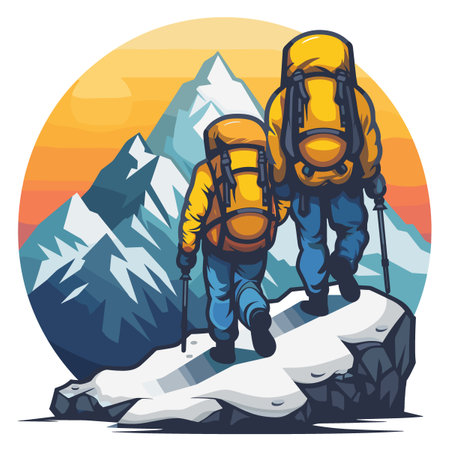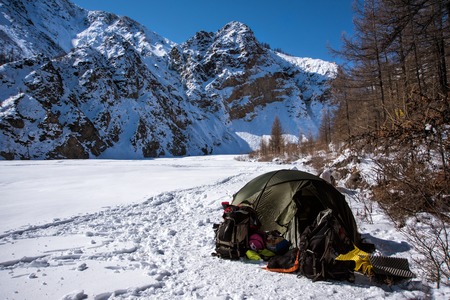Understanding the Unique Challenges of Indian Mountain Winters
Winter camping in the Indian mountains, whether you are heading to the mighty Himalayas, the lush Western Ghats, or any other high-altitude region, presents a distinct set of challenges that every camper must prepare for. Unlike typical winter getaways, these areas can surprise even seasoned travellers with their dramatic weather shifts and rugged terrain. The temperatures can plummet well below freezing, particularly in regions like Himachal Pradesh, Uttarakhand, or Sikkim, often accompanied by sudden snowstorms or icy winds known locally as “chillai kalan” in Kashmir.
The terrain is another crucial factor to consider. From rocky Himalayan passes with loose scree and hidden ice patches to dense forests of the Nilgiris covered with morning frost, footing can become treacherous very quickly. This is not just about dealing with cold; it’s about navigating unpredictable ground where every step counts. In addition, altitude sickness is a real concern above 2,500 metres, affecting both physical stamina and decision-making.
Regional challenges also vary widely. For example, while camping near Leh or Manali may expose you to biting winds and remote locations far from medical help, trekking in the southern ranges like Munnar or Coorg brings its own mix of cold rains and leech-infested trails. Local wildlife such as Himalayan black bears or wild dogs in the Western Ghats may require additional caution at campsites.
Understanding these unique aspects of Indian mountain winters is key to planning a safe and enjoyable camping experience. It’s not just about packing extra blankets; it’s about respecting local weather patterns, preparing for sudden changes in climate, and learning from the knowledge of indigenous communities who have lived in these mountains for generations.
2. Choosing the Right Tent and Gear for Indian Conditions
When it comes to winter camping in the Indian mountains, picking the right tent and gear is not just a matter of comfort—its about safety and survival. The Himalayas and other Indian ranges can see temperatures plummet below zero, especially at night. Here are some practical insights and recommendations for selecting tents and essential camping equipment tailored to Indian conditions.
Tents: Built for the Sub-Zero Challenge
Look for four-season tents that are specifically designed to withstand harsh mountain weather. In India, brands like Quechua (available at Decathlon), Wildcraft, and local adventure stores in cities like Dehradun, Manali, or Leh offer robust options. Features to prioritise include double-layered fabric for insulation, snow skirts, and strong aluminium poles. Dome-shaped tents perform well against wind and snowfall common in Indian winters.
| Tent Feature | Why It Matters | Indian Brand/Source |
|---|---|---|
| Double Layered Walls | Extra insulation against freezing winds | Quechua, Wildcraft |
| Snow Skirt | Keeps snow out of the sleeping area | Adventure 18 (Delhi), Local Leh markets |
| Ventilation Flaps | Reduces condensation inside tent | Decathlon, Local Adventure Shops |
Sleeping Bags: Go Local, Stay Warm
A sleeping bag rated for at least -10°C is a must. Look for mummy-shaped bags with hoods for maximum warmth. Indian brands such as Trek N Ride, Quechua, or custom-made ones from old city bazaars in Shimla or Leh can be both economical and effective. Always check the temperature rating before buying or renting.
Recommended Sleeping Bag Types:
- Synthetic fill bags: Affordable and dry quickly if wet—ideal for unpredictable mountain weather.
- Down fill bags: Lightweight and super warm but need careful storage in damp conditions found in Indian mountains.
Ground Mats: Don’t Underestimate Insulation from Below
The icy ground can sap your body heat rapidly. A thick foam mat or inflatable mattress from Kosha, Decathlon, or even traditional woolen rugs sourced from Himachal or Uttarakhand markets work well. Many seasoned campers layer a foam mat over a local rug for added insulation.
Packing Tip:
If weight is not an issue, carry two mats—one foam, one inflatable—for optimum protection.
Sourcing Gear Locally: A Smart Move
Local markets in Manali, Leh, Rishikesh, and Gangtok often have quality gear rentals at affordable rates. This not only supports local businesses but also allows you to test equipment suited to regional conditions before making big purchases. Remember to bargain—a common practice in Indian bazaars!
Selecting the right tent and gear is your first step towards a safe and memorable winter camping experience in the Indian mountains. Prioritise warmth, durability, and always consider gear from trusted Indian brands or local sources to get the best value and cultural fit for your adventure.

3. Layering and Clothing Tips: What Works Best in India
When planning a winter camping trip in the Indian mountains, smart layering is absolutely essential for staying warm and comfortable. Temperatures can dip drastically, especially at night, so blending traditional Indian winter wear with modern outdoor gear gives you the best of both worlds.
Thermal Wear: Your First Line of Defence
Begin with a reliable base layer – thermal inners made from cotton-blend or merino wool are widely available in Indian markets. These help trap body heat and wick away sweat, preventing chills. Decathlon, Wildcraft, and even your local market in cities like Delhi or Manali offer budget-friendly options.
Woollens: The Indian Way to Stay Warm
No Indian winter is complete without classic woollen sweaters, pullovers, and shawls. Kashmiri pashmina or Himachali woollen shawls are not just culturally significant but incredibly efficient at providing insulation. You’ll see locals using monkey caps (balaclavas) and mufflers — don’t hesitate to pack these! They’re lightweight, compact, and extremely effective at protecting your head and neck from icy winds.
Traditional Meets Technical
Layer your woollens over thermals for maximum warmth, but don’t skip out on technical jackets or fleeces if you have them. Modern down jackets or synthetic puffers add an extra barrier against the cold. In my own experience camping near Auli, pairing my old-school monkey cap with a waterproof shell jacket kept me perfectly cosy during sudden snow showers.
Waterproof Layers: Essential in the Himalayas
Indian mountains can surprise you with rain, sleet, or snowfall even when it seems unlikely. Carry a waterproof outer shell—raincoats or ponchos work well and are easily found in Indian stores. For your lower body, thermal leggings under quick-dry trekking pants keep you comfortable through wet trails and cold evenings.
Balancing Style & Practicality
While traditional attire like shawls adds cultural flair and warmth around the campfire, switch to technical gear during treks or when it’s actively snowing for better mobility and protection. Always keep spare socks (preferably woollen) handy; nothing ruins a Himalayan morning faster than cold, wet feet!
The key takeaway is to combine local knowledge—embracing monkey caps, shawls, and mufflers—with globally trusted outdoor technology for a truly effective winter camping wardrobe in India’s majestic mountains.
4. Food, Water, and Cooking Essentials for Mountain Winters
When camping in the Indian mountains during winter, planning your meals and hydration is just as important as packing the right tent or sleeping bag. The cold can sap energy quickly, and high altitudes demand more calories and smart hydration strategies. Here are some essential tips and local recommendations to keep you nourished and comfortable on your adventure.
Recommended Indian Staples for Winter Camping
| Staple | Why It’s Great | Preparation Tips |
|---|---|---|
| Chai (Tea) | Instant warmth, comfort, and a taste of home; helps fight altitude chills | Carry tea bags, milk powder, sugar, and a small thermos for quick brewing |
| Poha | Lightweight, easy to cook, high in carbs; ideal for breakfast or snacks | Pre-mix with peanuts and spices at home; just add hot water at camp |
| Instant Noodles | Quick meal, requires minimal water; comforting after a long trek | Add extra veggies or egg for nutrition; use a portable stove for fast cooking |
| Packed Parathas / Theplas | Stays fresh for 2-3 days; filling and familiar taste | Wrap in foil or cloth; eat with pickles or chutney for flavour boost |
| Sattu Drink Mix | Packed with protein, easy to prepare even in cold water; hydrates and energizes | Just mix with water and a pinch of salt/sugar; works well as a quick snack or breakfast drink |
Best Cooking Practices at High Altitude
- Use windproof stoves: Cold winds make open fires inefficient. Carry an LPG or butane stove with wind protection.
- Cook simple meals: At high altitudes, cooking takes longer due to lower air pressure. Stick to one-pot recipes and instant foods to save fuel and time.
- Soak grains/legumes overnight: If you plan to cook rice or dal, pre-soak them to reduce cooking time.
- Avoid frying: Oil takes longer to heat up in cold weather. Boiling or steaming is more practical.
- Carry ready mixes: Pre-mixed masalas or dehydrated curries save effort and spice up your meals without hassle.
Tips for Staying Hydrated in Cold & High-Altitude Conditions
The Challenge:
You might not feel thirsty in the cold, but dehydration happens faster due to dry air and increased breathing rate. Proper hydration prevents altitude sickness and keeps your energy up.
Hydration Strategies Table:
| Tip | Description/Implementation |
|---|---|
| Add warm fluids like chai or soup regularly throughout the day. | Keeps you warm while ensuring steady fluid intake—carry instant soup sachets or herbal teas. |
| Treat all water before drinking. | Always boil mountain stream water or use purification tablets/filters to avoid stomach issues. |
| Avoid excessive caffeine. | Coffee can dehydrate you—limit intake especially at higher altitudes where water loss is greater. |
| Melt snow safely if running low on water. | Melt thoroughly over your stove—don’t eat raw snow as it lowers body temperature rapidly. |
| Add glucose or electrolyte powders to water bottles. | This helps replenish lost salts during strenuous hikes—carry sachets like ORS or Glucon-D for emergencies. |
Packing thoughtfully chosen Indian staples, mastering efficient cooking methods suitable for mountain weather, and staying vigilant about hydration will ensure that your winter camping experience in the Indian Himalayas remains safe, comfortable, and deeply satisfying for both body and spirit.
5. Safety, Permits, and Local Regulations
Winter camping in the Indian mountains comes with its unique set of safety protocols and legal requirements. Obtaining the right permits is your first step – popular regions like Himachal Pradesh, Uttarakhand, Sikkim, and Ladakh often require trekkers and campers to secure Inner Line Permits (ILPs) or permissions from forest departments. Always check with local authorities or the tourism office before your journey.
Respecting Local Customs and Traditions
Indian mountain communities have deep-rooted traditions. It is essential to respect local customs – greet villagers with a polite “Namaste,” avoid entering sacred sites without permission, and dress modestly. Many areas observe eco-friendly practices; for example, carrying back your waste and avoiding plastic are not just rules but part of respecting their way of life.
Staying Connected with Authorities
Register your itinerary at the nearest police station or tourist office whenever possible. In remote regions, this helps in tracking your whereabouts in case of emergencies. Keep contact numbers of local police, forest officers, and mountain rescue services handy. Indian authorities appreciate proactive communication, especially during unpredictable winter conditions.
Interacting with Local Communities & Mountain Rescue Services
Indian hospitality is legendary—locals are often willing to help if you approach them respectfully. Offer a smile, share your plans honestly, and listen to their advice about weather changes or safe routes. If you face an emergency, know that mountain rescue services like the ITBP (Indo-Tibetan Border Police) and local trekking associations are reliable resources; don’t hesitate to reach out early.
By following these essential guidelines, you not only ensure your own safety but also build goodwill with the communities that call these majestic mountains home.
6. Health, First Aid, and Coping with Altitude
When camping in the Indian mountains during winter, your health and safety should always be a top priority. The harsh Himalayan or Western Ghats conditions require not just basic first aid preparedness but also awareness of altitude-related challenges unique to these regions.
Essential First Aid Items for Indian Camping Needs
Packing an effective first aid kit is crucial. Along with standard items like antiseptic creams, plasters, bandages, and painkillers, consider including:
- ORS (Oral Rehydration Salts) for dehydration
- Anti-diarrheal tablets (as local water may not always suit every stomach)
- Prescription medicines for fever and allergies common in Indian winters
- Inhalers if you have a history of breathing issues—cold air can trigger bronchospasms
- Thermal patches or balms for joint pains that often flare up in cold conditions
Common Health Concerns: AMS and More
Acute Mountain Sickness (AMS) is a real threat above 2,500 metres—common in Himalayan campsites like Auli, Manali, or Leh. Symptoms include headache, nausea, fatigue, and dizziness. Indians from the plains are as susceptible as foreign tourists. Apart from AMS, hypothermia and frostbite are concerns in sub-zero temperatures.
Tips on Acclimatisation: Local Wisdom & Ayurvedic Remedies
Traditional Indian wisdom offers practical tips for adapting to high altitudes:
- Slow ascent: Take it easy; don’t rush uphill treks. Spend a day or two at mid-altitude towns (like Joshimath or Shimla) before proceeding higher.
- Hydration: Drink warm fluids like ginger tea or lemon-honey water—popular among mountain locals—to stay hydrated and boost immunity.
- Pahadi diet: Local foods such as dal-chawal, khichdi, or millet rotis provide sustained energy without overloading your digestion.
Ayurvedic Support
Ayurveda suggests herbal remedies like ashwagandha, shilajit, and tulsi tea to improve stamina and adapt better to altitude changes. Many seasoned Indian trekkers carry small sachets of chyawanprash, which can be consumed daily for overall vitality.
By blending modern first aid with time-tested Indian practices, you can enjoy a safer and healthier winter camping experience amidst India’s breathtaking mountains.
7. Dos and Don’ts: Responsible Camping in the Indian Mountains
Core Guidelines for Eco-Friendly Camping
Winter camping in the Indian mountains is a privilege that comes with the responsibility of preserving these pristine environments. It’s crucial to adopt eco-friendly habits—choose biodegradable products, avoid plastic disposables, and pack out all your waste. Always use designated campsites where possible to minimise your impact on fragile landscapes, and keep your campsite small and unobtrusive.
The ‘Leave No Trace’ Principles
Adhering to ‘Leave No Trace’ guidelines is especially important in India’s mountain regions. Carry all rubbish back with you, including food scraps, wrappers, and hygiene products. Avoid making campfires wherever prohibited; instead, use portable stoves to cook. Do not pick plants or disturb natural features such as rocks or fallen branches, as these play vital roles in the local ecosystem.
Respecting Sacred Sites and Local Traditions
Many mountain trails and spots in India hold deep religious and cultural significance for local communities. Always respect signage indicating sacred areas—never set up tents or cook near shrines, temples, or sacred rivers. Dress modestly and behave respectfully when passing through villages or encountering locals, especially in states like Uttarakhand, Himachal Pradesh, and Sikkim.
Tips for Harmonious Interaction with Flora and Fauna
The Indian Himalayas are home to rare wildlife such as snow leopards, Himalayan monals, and red pandas. Observe animals from a distance and never feed them. Store food securely inside your tent or hang it away from reach to avoid attracting wild animals. Stick to established trails to prevent trampling on delicate alpine vegetation which takes years to regenerate.
Building Positive Relations with Local Communities
Support local economies by hiring local guides and purchasing regional products instead of imported items. Greet villagers with a friendly “Namaste” or “Juley” (in Ladakh), and always seek permission before photographing people or their homes. Share space considerately at communal water sources and avoid polluting streams—use a bucket for washing away from water bodies.
Quick Dos:
- Pack reusable utensils and bottles
- Use eco-friendly toiletries
- Follow marked trails
- Learn basic phrases in local languages
Quick Don’ts:
- Avoid loud music or parties at campsites
- Do not light open fires unless absolutely necessary
- Avoid single-use plastics
- Never trespass into restricted or private lands
By following these dos and don’ts while winter camping in the Indian mountains, you help conserve these magical places for generations to come—and foster goodwill with both nature and the communities who call these peaks home.


